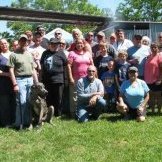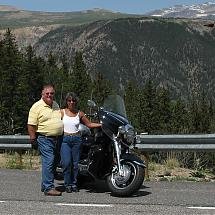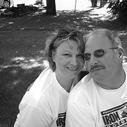Search the Community
Showing results for tags 'data'.
-
I'm having a serious case of the screammin meamies. I am on vacation! Plans for the week included buying a 1T portable hard drive to back up my laptop onto. Hard drive was bought but said plans got put off due to other things getting in the way as in one of my mares doing her best to make my vet rich. The "fun" began when said laptop locked up while I was online. Tried activating the Task Manager to shut it down and restart the puter but the program would not come up so I just turned it off. Apparently that has corrupted my hard drive and the puter will not load into Windows. Fortunately I have 2 laptops so I was able to access Gateway's website and find out what I needed to do to get it back up and running. Gateway said to pull the hard drive, copy it so I would not lose all of my data and set the puter back to factory specs which would erase any data on the hard drive. I went down to Best Buy to have the Geek Squad check it and according to them, the data on the hard drive cannot be accessed so I've had to buy a new hard drive. Not a biggie except for one minor detail. . . . All of the stuff I have loaded on said hard drive, pics, a ton of bookmarks, a semi serious collection of eBooks [Kindle!] and an equally semi serious collection of audio books! OUCH! To top it off, the Geek Squad informed me that a MINIMUM charge of $250, which could go as high as $2500, would be needed to send the old hard drive off for data recovery. And that is not including the cost of another portable hard drive to copy the data onto. OUCH!! The HELP! is this: Is there anyone out there that can do the data recovery without it costing me the proverbial arm and a leg ? Any recomendations for someone who could?? I can redownload the ebooks and the audiobooks but considering how slow my internet connection can be, that could take forever. Also the pics, bookmarks and assorted other goodies, for the most part, cannot be replaced. HELP!!!
-
The following post from Freebird got me thinking. How can I determine how much data I currently use, to determine future options? I am possibility looking to change jobs, and the new employeer is asking me to be within 45 minutes distance, which would require moving. This weekend I looked at an interesting place, but severly lacking internet wise. ATT telco but no DSL, no CATV. Only saving grace is in sight of, and 5 bars of ATT 4G cell tower. Currently 4 computers at home running on catv 6meg service. Never download movie or music, but sometimes large document files. Lot of ebay and VR.org:). What would be options for home based cell internet? How can I now figure typical data use at current home? Any other suggestions-I know find different house.
- 4 replies
-
- blackberry
- data
-
(and 3 more)
Tagged with:
-
If you have ten minutes of time, and you want to take my 30 question trully exciting market survey. I'd appreciate it. It is for college credit, and not for profit. Results are anonomous. I plan to download the data Sat night so I can spend next week writing my report. http://mtubusiness.us2.qualtrics.com/SE/?SID=SV_8ohC4XobFwKOFKc thanks sorry for spamming the board
-
I am heading for the US several times this winter. I have an unlocked iPhone 4S and was wondering if any of the American Cellular Providers offer free roaming data charges? I am looking to get a Pay As You Go Sim Card.
-
I preordered the new Iphone 4 early on the 15th and Fed Ex delivered it today. I like it. It's much improved over the Iphone 3G that I had. It was a snap to switch over from my old phone. The new phone is much faster. The apps are much snappier and the 3G data transfer now approaches broadband speed. It seems that the old Iphone wasn't capable of processing the data at 3G speeds. The new phone seems to correct that. There are many new features and the phone seems easier to hold. Not as slippery as the original. I just love new toys... Dennis
-
I installed a 165-80-15 Nexen SB-802 on my TD yesterday and I went out and rode about 250 miles on it just to get a feel for it. I must say that I love it!! I'll gladly answer and questions. I posted the info on the DS tire data base.
-
I got this email through the MSF communication forum. If you are interested, they would like you to take a survey http://tinyurl.com/VTTIDASsurveyV2
-
I have read in past post there are some here that work with SQL. So this questions is for them. First off let me say, I'm not a comupter expert by any means. What little knowledge I have is "self taught". I have built a few "DOS" data bases, some of which are still in use. But I feel it's time to look into a Window Data Base software. So, I am playing around with 2005 express (to use as a back end) and then some other software as the UI (any suggestion would be great!). Maybe with a little more time I could answer my own question, but no one ever said I was patience. So, here's my question. Does SQL allow field calulations? Or is this all done in Scripts and Queries? In DOS a formula could be enter right into a field that would perform calulations based on information that had been entered into other fields. I have scanned thru a book, but never saw any reference to this. Chuck
-
Does anyone know if it is neccessary to rejet if you add the bub slip ons?I have heard conflicting data.
-
here is the Data i have...
-
Just want to share some info on how to make your own POI'S .Here are three little programs that work nicely . 1: ([POI Harvester), this one will collect data from google or Yahoo, you type the name of what your looking for , the zip code of the area and the radius in miles and then you save it in a csv file whit Excel. 2: (csvedsetup)to make corrections and keep data on four columns e,g ( Hampton Inn City / State Lattitude longitude ) 3: (Poi Edit) to make any conversion to the make or model of GPS that you have .This one is easy to get on the web. Here are the two others A few tries and you should get it right .
- 7 replies
-
- columns
- corrections
-
(and 2 more)
Tagged with:
-
No matter how I enter the searches, I cant find the part numbers for the Honda windshield vent.... and how to install it? Can somebody help me find this data?
-
(Addresses at bottom of article) Transportation Department Documents and Publications February 26, 2007 Title: Motorcycle Crash Causation Study and Pilot Motorcycle Crash Causes and Outcomes Study. DATES: Please submit comments by March 28, 2007. Background: In 2005, 4,553 motorcyclists were killed and 87,000 were injured in traffic crashes in the United States, increases of 13 percent, and 14 percent respectively from 2004. Per vehicle mile traveled in 2004, motorcyclists were about 34 times more likely to die, and 8 times more likely to be injured in a motor vehicle crash than were passenger car occupants. Per 100 million miles traveled, in 2004, motorcyclist fatalities were 77 percent higher than they were in 1994. This compares with a decrease of 22 percent in fatality rates for occupants in passenger vehicles over the same period. These data show that the motorcycle crash problem is becoming more severe. /1/ Congress has recognized this problem and directed the DOT to conduct research that will provide a better understanding of the causes of motorcycle crashes. Specifically, in Section 5511 of the Safe, Accountable, Flexible, Efficient Transportation Equity Act: A Legacy for Users (SAFETEA-LU) Pub. L. 109-59, Congress directed the Secretary of Transportation to provide grants to the Oklahoma Transportation Center (OTC) for the purpose of conducting a comprehensive, in-depth motorcycle crash causation study that employs the common international methodology for in-depth motorcycle crash investigation developed by the Organization for Economic Cooperation and Development (OECD). /2/ SAFETEA-LU authorized $1,408,000 for each of fiscal years 2006 and 2007, but provided for an equal match by the Grantee (Sections 5511 and 5101). The Secretary delegated authority to FHWA for the Motorcycle Crash Causation Grants under Section 5511 (71 FR 30831). FOOTNOTE 1 More detailed information on motorcycle crashes can be found in Traffic Safety Facts--Motorcycles, published by NHTSA and available on its Web site at: http://www-nrd.nhtsa.dot.gov/pdf/nrd-30/NCSA/TSF2005/MotorcyclesTSF05.pdf. END FOOTNOTE FOOTNOTE 2 The OECD methodology may be obtained by sending a request to jtrc.contact@oecd.org. END FOOTNOTE Coordination of FHWA Main Study and NHTSA Pilot Study Prior to the SAFETEA-LU directive by Congress to administer a full-scale study of motorcycle crash causes, NHTSA awarded a contract to conduct a pilot study of Motorcycle Crash Causes and Outcomes. The intent of this pilot study is to examine appropriate applications of the OECD methodology to motorcycle crashes in the United States. This pilot test is needed before any full-scale study could be conducted because the OECD methodology has not previously been implemented in the United States, and also because this methodology incorporates some options for collecting crash and control sample data that are affected by logistical and budget constraints. The authorization of funds by Congress for a full-scale motorcycle crash study provided an opportunity for the NHTSA pilot study to become closely coordinated with the FHWA full-scale study. As a result, the pilot study will test the procedures FHWA will consider using as it implements the OECD methodology. Additionally, it may be possible for the pilot study to transition directly into the main study, thereby allowing the main study to avoid many startup costs (e.g., site selection, training, coding manual development, data form development, etc.) that it otherwise would have incurred. This will allow the main study to capture a larger sample of crashes with the available funding. Recognizing these advantages, the DOT intends to submit a single request to OMB for approval of both of these studies. This notice is the first step in that combined approval request. Project Working Group Guidance A project working group consisting of representatives from the motorcycle industry and from the motorcycle community was formed to provide input into the study design. A working group meeting was held in Denver on June 15-16, 2006. At this meeting, consensus was reached that all the relevant OECD variables would be captured in both the NHTSA pilot and FHWA full-scale studies, that some of these variables would need to be modified to conform to U.S. requirements, and that other variables would need to be added to provide necessary data related to the U.S. roadway environment. Proposed Data Acquisition Methodology Use of Parallel and Complementary Procedures The OECD describes two complementary procedures to be performed for acquiring the data needed to understand the causes of motorcycle crashes. The first of these is the traditional in-depth crash investigation that focuses on the sequence of events leading up to the crash, and on the motorcycle, rider, and environmental characteristics that may have been relevant to the crash. The second procedure, known as the case-control procedure, complements the first. It requires the acquisition of matched control data to allow for a determination of the extent to which rider and driver characteristics, and pre-crash factors observed in the crash vehicles, are present in similarly-at-risk control vehicles. Such a dual approach offers specific advantages to the understanding of crashes and the development of countermeasures. The in-depth study of the crash by itself allows for analysis of the events antecedent to the crash, some of which, if removed or altered, could result in a change in subsequent events that would have led to a non-crash, or reduced crash severity outcome. For example, an in-depth crash investigation may reveal that an automobile approaching an intersection was in a lane designated for straight through traffic only, but the motorist proceeded to make a left turn from that lane into the path of an oncoming motorcycle. That finding can, by itself, be used to develop countermeasures, and does not require matched control data. However, acquiring matched control data from similarly-at-risk riders and drivers provides additional critical information about crash causes that cannot be obtained if only crashes are examined. The main purpose of acquiring matched data is to allow for inferences to be made regarding risk factors for crash causes. A brief explanation is provided here so that those less familiar with case-control procedures will understand the advantage of acquiring controls. /3/ Consider a hypothetical situation where it is observed that the proportion of motorcycle riders involved in crashes that have a positive Blood Alcohol Content (BAC) is the same as the proportion of matched (similarly-at-risk) control motorcycle riders not involved in crashes. And assume that the proportion of passenger-vehicle motorists who crash with motorcycles at a positive BAC is greater than matched control passenger-vehicle motorists. These data considered together would suggest that for crashes involving passenger vehicles and motorcycles, alcohol is a bigger risk factor for passenger vehicle drivers than it is for motorcycle riders. That is, the relative risk of crash involvement attributable to alcohol in motorcycle-automobile crashes is greater for passenger-vehicle motorists than for motorcyclists. Other risk factors for crashes (i.e., age, gender, riding and driving experience, fatigue level) for both motorcyclists and motorists can also be examined in this manner. If scaled interval measurements of risk factor levels are obtained (for example, if the level of alcohol is measured, not just its presence or absence), then it becomes possible to calculate functions showing how risk changes with changes in the variable of interest. Such risk functions are highly useful in the development of countermeasures. /4/ FOOTNOTE 3 This being a study of crashes involving motorcycles, data will be acquired from both crash-involved motorcycles and also motor vehicles involved in those crashes as countermeasures may be developed separately for each that could lead to a reduction in crashes involving motorcycles. Similarly, when control data are acquired, data from similarly-at-risk motorcycle rider controls and similarly-at-risk automobile driver controls will also be acquired. This way a balanced picture of the causes of crashes involving motorcycles and other vehicles will emerge. END FOOTNOTE FOOTNOTE 4 Certainly other outcomes besides the one presented are possible, and other comparisons are of interest. For example it would be useful to compare crash-involved motorcyclists to non-crash involved motorcyclists and crash-involved passenger vehicle motorists to non-crash involved passenger-vehicle motorists. These comparisons would allow for estimates of changes in relative risks for riders and drivers independently. END FOOTNOTE ADDRESSES: You may send comments within 30 days to the Office of Information and Regulatory Affairs, Office of Management and Budget, 725 17th Street, NW., Washington, DC 20503, Attention DOT Desk Officer. You are asked to comment on any aspect of this information collection, including: (1) Whether the proposed collection is necessary for the FHWA's performance; (2) the accuracy of the estimated burden; (3) ways for the FHWA to enhance the quality, usefulness, and clarity of the collected information; and (4) ways that the burden could be minimized, including the use of electronic technology, without reducing the quality of the collected information. All comments should include the Docket number FHWA-2007-26843. FOR FURTHER INFORMATION CONTACT: For questions concerning the FHWA Motorcycle Crash Causation Study, please contact Carol Tan, Ph.D, Office of Safety Research and Development (HRDS), at (202) 493-3315, Turner-Fairbank Highway Research Center, Federal Highway Administration, 6300 Georgetown Pike, McLean, VA 22101, between 9 a.m. and 5:30 p.m., Monday through Friday, except Federal holidays. For questions concerning the Pilot Motorcycle Crash Causes and Outcomes Study, please contact Paul J. Tremont, Ph.D, Office of Behavioral Safety Research, NTI-131, at (202) 366-5588, National Highway Traffic Safety Administration (NHTSA), 400 Seventh Street, SW., Washington, DC 20590, between 7:30 a.m. and 4 p.m. Monday through Friday, except Federal holidays.











